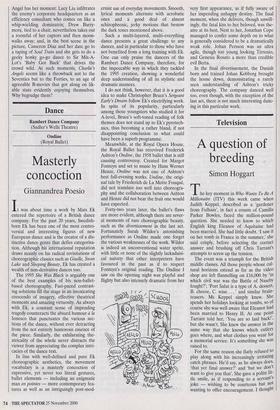Dance
Rambert Dance Company (Sadler's Wells Theatre) Ondine (Royal Ballet)
Masterly concoction
Giannandrea Poesio
It was about time a work by Mats Ek entered the repertoire of a British dance company. For the past 20 years, Swedish- born Ek has been one of the most contro- versial and interesting figures of new European dance and is the creator of a dis- tinctive dance genre that defies categorisa- tion. Although his international reputation draws mainly on his radical revisitations of choreographic classics such as Giselle, Swan Lake and Sleeping Beauty, Ek has created a wealth of non-derivative dances too.
The 1995 She Was Black is arguably one of the best examples of his non-ballet- based choreography. Fast-paced contrast- ing solutions fill the stage in an intoxicating crescendo of imagery, effective theatrical moments and amazing virtuosity. As always with Ek, a constant sense of impending tragedy counteracts the absurd humour a la Ionesco that punctuates the various sec- tions of the dance, without ever detracting from the not entirely humorous essence of the piece. Similarly, the exhilarating the- atricality of the whole never distracts the viewer from appreciating the complex intri- cacies of the dance text.
In line with well-defined and pure Ek choreographic aesthetics, the movement vocabulary is a masterly concoction of expressive, yet never too literal gestures, ballet elements — including an enigmatic man en pointes — more contemporary fea- tures as well as an intriguingly post-mod- enlist use of everyday movements. Smooth, lyrical moments alternate with acrobatic ones and a good deal of almost schizophrenic, jerky motions that bestow the dark tones mentioned above.
Such a multi-layered, multi-everything dance presents a great challenge to any dancer, and in particular to those who have not benefited from a long training with Ek. One can only praise the dancers of the Rambert Dance Company, therefore, for the impeccable way in which they tackled the 1995 creation, showing a wonderful deep understanding of all its stylistic and dramatic nuances.
I do not think, however, that it is a good idea to make Christopher Bruce's Sergeant Early's Dream follow Ek's electrifying work. In spite of its popularity, particularly among those youngsters who studied it for A-level, Bruce's soft-toned reading of folk themes does not stand up to Ek's pyrotech- nics, thus becoming a rather bland, if not disappointing conclusion to what could have been a superb programme.
Meanwhile, at the Royal Opera House, the Royal Ballet has rerevived Frederick Ashton's Ondine, the 1958 ballet that is still causing controversy. Created for Margot Fonteyn and set to music by Hans Werner Henze, Ondine was not one of Ashton's best full-evening works. Undine, the origi- nal tale by Friederich de La Motte Fouque, did not translate too well into choreogra- phy and the collaboration between Ashton and Henze did not bear the fruit one would have expected.
Forty-two years later, the ballet's flaws are more evident, although there are sever- al moments of rare choreographic beauty, such as the divertissement in the last act. Fortunately Sarah Wildor's astonishing performance as Ondine made one forget the various weaknesses of the work. Wildor is indeed an unconventional water sprite, with little or none of the slightly lackadaisi- cal naivety that other interpreters have favoured in the past as if to respect Fonteyn's original reading. The Ondine I saw on the opening night was playful and flighty but also intensely dramatic from her very first appearance, as if fully aware of her impending unhappy destiny. The final moment, when she delivers, though unwill- ingly, the fatal kiss to her beloved, was the- atre at its best. Next to her, Jonathan Cope managed to confer some depth on to what is generally considered to be a dramatically weak role. Johan Persson was an ultra agile, though too young looking Tirrenio, and Genesia Rosato a more than credible evil Berta.
In the final divertissement, the Danish born and trained Johan Kobborg brought the house down, demonstrating a rarely seen understanding of Ashton's tricky choreography. The company danced well too, even though, with the exception of the last act, there is not much interesting danc- ing in this particular work.





























































































 Previous page
Previous page